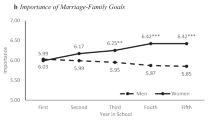Abstract
The present study was conducted over a four-year period to determine if life history or biographical information could be used to predict various college experiences of women. At the beginning of their freshman year, 897 women were administered a comprehensive life history questionnaire. During the last quarter of their senior year, 327 women (who received the life history questionnaire four years earlier) completed an inventory which assessed major dimensions of college experiences. Results indicated that life history data could be used to make longitudinal predictions of women's college experiences. The results were discussed in terms of their implications for counseling students in higher education.
Similar content being viewed by others
References
Berdie, R. F., Pilapil, B., and Im, I. J. (1970). Entrance correlates of university satisfaction. American Educational Research Journal 7:251–266.
Borgen, F. H., and Weiss, D. J. (1971). Cluster analysis and counseling research. Journal of Counseling Psychology 18:583–591.
Claudy, J. G. (1970). An empirical investigation of small sample multiple regression and cross-validation. Doctoral dissertation, University of Tennessee, Ann Arbor, Michigan: University Microfilms, no. 70–7553.
Cronbach, L. J., and Gleser, G. C. (1973). Assessing similarity between profiles. Psychological Bulletin 50:456–473.
Dunnette, M. D. (1963). A modified model for test validation and selection research. Journal of Applied Psychology 47:317–323.
Elton, C. F., and Rose, H. A. (1966). Within-university transfers: Its relation to personality characteristics. Journal of Applied Psychology 50:539–543.
Feild, H. S. (1973). Subgroup and individual differences in the quasi-actuarial assessment of behavior: A longitudinal study. Unpublished doctoral dissertation, University of Georgia.
Feild, H. S., Lissitz, R. W., and Schoenfeldt, L. F. (1975). The utility of homogeneous subgroups and individual information in prediction. Multivariate Behavioral Research 10:449–462.
Feild, H. S., and Schoenfeldt, L. F. (1975a). Development and application of a measure of students' college experiences. Journal of Applied Psychology 60:491–497.
Feild, H. S., and Schoenfeldt, L. F. (1956). Ward and Hook revisited: A two-part procedure for overcoming a deficiency in the grouping of persons. Educational and Psychological Measurement 35:171–174.
Ferdinand, T. N. (1966). “Typologies of delinquency: A Critical Analysis.” New York: Random House.
Fretz, B. R. (1972). Predicting career preference from preadolescent development. Journal of Counseling Psychology 19:286–291.
Holland, J. C. (1966). “The Psychology of Vocational Choice.” New York: Blaisdell.
Johansson, C. B., and Rossmann, J. E. (1973). Persistence at a liberal arts college: A replicated, five-year longitudinal study. Journal of Counseling Psychology 20:1–9.
Lavin, D. C. (1965). “The Prediction of Academic Performance.” New York: Russell Sage Foundation.
Longino, C. F., and Kart, C. S. (1973). The college fraternity. An assessment of theory and research. Journal of College Student Personnel 14:118–125.
Owens, W. A. (1968). Toward one discipline of scientific psychology. American Psychologist 23:782–785.
Owens, W. A. (1971). A quasi-actuarial basis for individual assessment. American Psychologist 26:992–999.
Owens, W. A. (1975). Background data. In “Handbook of Industrial and Organizational Psychology” (Dunnette, M. D., ed.). Chicago, Illinois: Rand-McNally.
Piaget, J. (1963). “The Origins of Intelligence in Children.” New York: Norton.
Schoenfeldt, L. F. (1975). Utilization of manpower: Development and evaluation of an assessment-classification model for matching individuals with jobs. Journal of Applied Psychology 59:583–595.
Stahmann, R. F. (1969). Predicting graduation major field from freshmen entrance data. Journal of Counseling Psychology 16:109–113.
Toops, H. A. (1948). The use of addends in experimental control, social census, and managerial research. Psychological Bulletin 45:41–74.
Toops, H. A. (1946). The research possibilities of addends. “Proceedings of the Research Forum.” Endicott, New York: International Business Machines.
Ward, J. H., and Hook, M. E. (1963). Application of an hierarchical grouping procedure to a problem of grouping profiles. Educational and Psychological Measurement 23:69–81.
Warren, J. R., and Roelfs, P. J. (1972). Student reactions to college: The development of a questionnaire through which junior college students describe their college experiences. Research project report 72–23. Princeton, New Jersey: Educational Testing Service.
Author information
Authors and Affiliations
Rights and permissions
About this article
Cite this article
Feild, H.S. Predicting women's college experiences from life history data: A four-year study. Res High Educ 5, 125–140 (1976). https://doi.org/10.1007/BF00992007
Issue Date:
DOI: https://doi.org/10.1007/BF00992007




